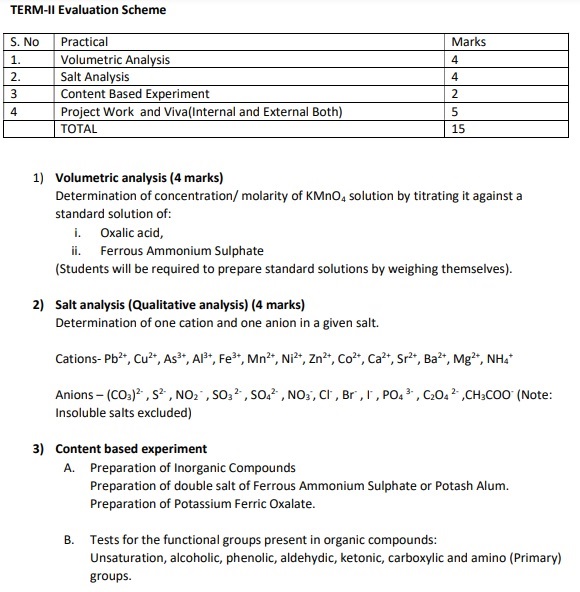Check Term 2 CBSE Class 12 Chemistry Syllabus 2021-22 which is available here for download in PDF format. The link to download (Term 2) CBSE Class 12 Chemistry Syllabus 2021-22 is given at the end of this article. Also, find the sample paper for Class 12 CBSE Chemistry below
Latest* CBSE Class 12 Term 2 Exam 2022: Most Important Topics in Physics, Chemistry & Bio| CBSE Board Exams
EXCLUSIVE: Term 2- CBSE Class 12 Chemistry Board Exam 2022: Resources, Questions & Answer Writing Tips To Score 90% Marks
Term 2 – CBSE Class 12 Chemistry Syllabus 2021-22:
| S. No. | Unit | No. of Periods | Marks |
| 1 | Electrochemistry | 7 | 13 |
| 2 | Chemical Kinetics | 5 | |
| 3 | Surface Chemistry | 5 | |
| 4 | d-and f-Block Elements | 7 | 9 |
| 5 | Coordination Compounds | 8 | |
| 6 | Aldehydes, Ketones and Carboxylic Acids | 10 | 13 |
| 7 | Amines | 7 | |
|
| Total | 49 | 35 |
Electrochemistry: Redox reactions, EMF of a cell, standard electrode potential, Nernst equation and its application to chemical cells, Relation between Gibbs energy change and EMF of a cell, conductance in electrolytic solutions, specific and molar conductivity, variations of conductivity with concentration, Kohlrausch's Law, electrolysis.
Chemical Kinetics: Rate of a reaction (Average and instantaneous), factors affecting rate of reaction: concentration, temperature, catalyst; order and molecularity of a reaction, rate law and specific rate constant, integrated rate equations and half-life (only for zero and first order reactions).
NCERT Solutions for Class 12 Chemistry & Other Subjects
Surface Chemistry: Adsorption - physisorption and chemisorption, factors affecting adsorption of gases on solids, colloidal state: distinction between true solutions, colloids and suspension; lyophilic, lyophobic, multi-molecular and macromolecular colloids; properties of colloids; Tyndall effect, Brownian movement, electrophoresis, coagulation.
d-and f-Block Elements: General introduction, electronic configuration, occurrence and characteristics of transition metals, general trends in properties of the first row transition metals – metallic character, ionization enthalpy, oxidation states, ionic radii, colour, catalytic property, magnetic properties, interstitial compounds, alloy formation. Lanthanoids - Electronic configuration, oxidation states and lanthanoid contraction and its consequences.
Coordination Compounds: Coordination compounds - Introduction, ligands, coordination number, colour, magnetic properties and shapes, IUPAC nomenclature of mononuclear coordination compounds. Bonding, Werner's theory, VBT, and CFT.
Aldehydes, Ketones and Carboxylic Acids: Aldehydes and Ketones: Nomenclature, nature of carbonyl group, methods of preparation, physical and chemical properties, mechanism of nucleophilic addition, reactivity of alpha hydrogen in aldehydes, uses.
Carboxylic Acids: Nomenclature, acidic nature, methods of preparation, physical and chemical
properties; uses.
Amines:
Amines: Nomenclature, classification, structure, methods of preparation, physical and chemical properties, uses, identification of primary, secondary and tertiary amines.
Practical:
Term II: At the end of Term II, a 15-mark Practical would be conducted under the supervision of Board appointed external examiners. This would contribute to the overall practical marks for the subject.
OR
In case the situation of lockdown continues beyond December 2021, a Practical Based Assessment (pen-paper) of 10 marks and Viva 5 marks would be conducted at the end of Term II jointly by the external and internal examiners and marks would be submitted by the schools to the Board. This would contribute to the overall practical marks for the subject.
Term - II Evaluation Scheme

Download Term 2 – CBSE Class 12 Chemistry Syllabus 2021-22 (PDF)
Also Read: Click here to Check BSEB 12th Result 2022
Comments
All Comments (0)
Join the conversation